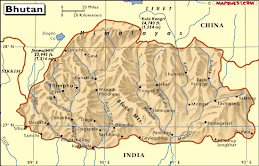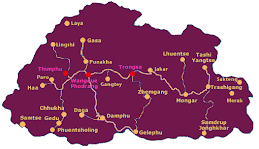20.1.08
Day 15: Road to Ura
Today, I run with Dendup ‘Chapsa’ Tshering, a sturdy English student with a wide grin and bread loaf thighs, who tends to drink too much suja for breakfast and dart repeatedly into the bushes at the side of the road (chapsa means toilet). To my right is a cracked wall of orange rock, at times leaning over the road and threatening to collapse on us; it is adorned with black pancakes of lichen and the odd Buddhist message in Sanskrit. To my left is a drop of some five hundred metres to the valley floor. Presumably, there’s a river down there, but all I see is a procession of dark green interlocking knuckles of forest smudged by haze. The sun is out and it is suddenly warm. I am in t-shirt and shorts. The road loops around the vast corrugations in the side of the mountain. At each exposed point, there is a fresh view of the valley, a brisk wind and a line of white concrete posts to stop cars careering off the road into oblivion. In the recesses, there are sprinkles of snow, glittering iced-over streams and rhododendron bushes for Dendup.
“KUZUZANGBO!!” I bellow to a road worker breaking rock with a hammer. She squats on her haunches, face wrapped in a pink scarf, baby in a blanket strapped to her back. She waves with a dust-whitened hand.
Eleven kilometres of the twenty to do to reach the alpine village of Ura, and I notice a change of vegetation. The hardy silver fir and hemlock near the pass at 3500 metres are now integrated with and slowly replaced by juniper, larch and chir pine. Chir pine is particularly appealing, the clusters of light green needles waving in the wind are like chimney sweeper brushes. A large, brown eagle with broad shoulders glides across the road from above and disappears into the conifers. I look up for others and see a white tri-peaked wedge of rock resplendent in the sunlight against a cloudless sky, a galleon in full sail riding on conifer waves. This is Ganghar Puensum, Bhutan’s tallest mountain at 7541 metres (puen meaning relative, sum three). We are just over half way across the kingdom; Ganghar Puensum is a glimpse of the west. Unfortunately, I can’t bellow “Yalama!” (Wow!) to Dendup; he’s otherwise engaged.
Tony Robinson-Smith
Project Leader
Day 22: Jinlap
The Lam Neten (abbot) of the dzong is a tall, stooping, silver-haired man of sixty-seven with a raspy voice and gentle demeanour. If he understood English, I feel like I could tell him my problems. Nadya and I are in his chamber with Tshering Dorji and Yenten Jamtsho to ask for donations for the Tara-thon. Monks in Bhutan are not poor; they are paid well for the pujas and blessings they give. Trongsa Dzong is a handsome, commanding structure overlooking the Mangde River with tall leaning white walls banded in red near the top and spreading pagoda roofs. It is the longest dzong in the country. Tall cypress trees stand outside, monkeys climb the walls using the lightning conductors and copper roosters peck between the flagstones within for grains of rice.
Tshering and Yenten are wearing their ghos and we sit in a neat line on a carpeted bench in a small chamber on the top floor. Nadya is in her kira, I in collared shirt, slacks and smart shoes. Nadya informs the lama through Tshering that we know the Lam Netens of both Mongar and Trashigang dzongs. We also know Doctor Jagar Dorji, former principal of Sherubtse College, who is from nearby Tangsibi village. The abbot tells us he is Doctor Jagar’s cousin and then shares his thoughts on our charity project while a young monk serves tea and biscuits.
“First of all, Lam say he is very pleased to see Sar and Madam,” Tshering translates, “and that Sar and Madam are doing very good job for the country. He say this type of work should be done by Bhutanese and why we don’t do this one? He says like that, Sar.” I nod and smile. “He say ‘ma di di pay tendel di di’. That means we people don’t, um, know… where we are going.” Tshering scratches his head, looks to Yenten for help.
“We meet each other without knowing” Yenten says enthusiastically. “We don’t plan to meet, but… we meet.”
“Fate brings us together,” summarizes Nadya.
“Yes, Maam.”
Lam Neten beckons to his secretary who takes an orange envelope out from under his red robes. The Lam takes it and summons us. We get up and in turn shake Lam Neten’s hand. Nadya receives the envelope and gets a kada - a long shiny white silk scarf - put around her neck. The lama utters a few words.
“He say he don’t have big amount to give, only 10,000. He says all the monks will pray for our safe reach to Thimphu.”
Each of us gets jinlap, a small wallet of yellow folded paper, Sanskrit words printed on it, tied with blue and red string. I open it later and find six black pepper seeds inside.
“Not pepper, Sar! Medicinal plant prepared by big lama. Each lama have different recipe.” The Lam Neten of Trashigang Dzong gave me one of these on our departure day three weeks ago. “We must take it, Sar, before eating in the morning, even before drinking cup of tea. It should be taken when we suffer a lot. It will cure our sufferings. Our pains will be decrease.”
Maybe I should take it in a couple of days’ time, when we are in the middle of the climb to our fourth mountain pass.
Tony Robinson-Smith
Project Leader
Today, I run with Dendup ‘Chapsa’ Tshering, a sturdy English student with a wide grin and bread loaf thighs, who tends to drink too much suja for breakfast and dart repeatedly into the bushes at the side of the road (chapsa means toilet). To my right is a cracked wall of orange rock, at times leaning over the road and threatening to collapse on us; it is adorned with black pancakes of lichen and the odd Buddhist message in Sanskrit. To my left is a drop of some five hundred metres to the valley floor. Presumably, there’s a river down there, but all I see is a procession of dark green interlocking knuckles of forest smudged by haze. The sun is out and it is suddenly warm. I am in t-shirt and shorts. The road loops around the vast corrugations in the side of the mountain. At each exposed point, there is a fresh view of the valley, a brisk wind and a line of white concrete posts to stop cars careering off the road into oblivion. In the recesses, there are sprinkles of snow, glittering iced-over streams and rhododendron bushes for Dendup.
“KUZUZANGBO!!” I bellow to a road worker breaking rock with a hammer. She squats on her haunches, face wrapped in a pink scarf, baby in a blanket strapped to her back. She waves with a dust-whitened hand.
Eleven kilometres of the twenty to do to reach the alpine village of Ura, and I notice a change of vegetation. The hardy silver fir and hemlock near the pass at 3500 metres are now integrated with and slowly replaced by juniper, larch and chir pine. Chir pine is particularly appealing, the clusters of light green needles waving in the wind are like chimney sweeper brushes. A large, brown eagle with broad shoulders glides across the road from above and disappears into the conifers. I look up for others and see a white tri-peaked wedge of rock resplendent in the sunlight against a cloudless sky, a galleon in full sail riding on conifer waves. This is Ganghar Puensum, Bhutan’s tallest mountain at 7541 metres (puen meaning relative, sum three). We are just over half way across the kingdom; Ganghar Puensum is a glimpse of the west. Unfortunately, I can’t bellow “Yalama!” (Wow!) to Dendup; he’s otherwise engaged.
Tony Robinson-Smith
Project Leader
Day 22: Jinlap
The Lam Neten (abbot) of the dzong is a tall, stooping, silver-haired man of sixty-seven with a raspy voice and gentle demeanour. If he understood English, I feel like I could tell him my problems. Nadya and I are in his chamber with Tshering Dorji and Yenten Jamtsho to ask for donations for the Tara-thon. Monks in Bhutan are not poor; they are paid well for the pujas and blessings they give. Trongsa Dzong is a handsome, commanding structure overlooking the Mangde River with tall leaning white walls banded in red near the top and spreading pagoda roofs. It is the longest dzong in the country. Tall cypress trees stand outside, monkeys climb the walls using the lightning conductors and copper roosters peck between the flagstones within for grains of rice.
Tshering and Yenten are wearing their ghos and we sit in a neat line on a carpeted bench in a small chamber on the top floor. Nadya is in her kira, I in collared shirt, slacks and smart shoes. Nadya informs the lama through Tshering that we know the Lam Netens of both Mongar and Trashigang dzongs. We also know Doctor Jagar Dorji, former principal of Sherubtse College, who is from nearby Tangsibi village. The abbot tells us he is Doctor Jagar’s cousin and then shares his thoughts on our charity project while a young monk serves tea and biscuits.
“First of all, Lam say he is very pleased to see Sar and Madam,” Tshering translates, “and that Sar and Madam are doing very good job for the country. He say this type of work should be done by Bhutanese and why we don’t do this one? He says like that, Sar.” I nod and smile. “He say ‘ma di di pay tendel di di’. That means we people don’t, um, know… where we are going.” Tshering scratches his head, looks to Yenten for help.
“We meet each other without knowing” Yenten says enthusiastically. “We don’t plan to meet, but… we meet.”
“Fate brings us together,” summarizes Nadya.
“Yes, Maam.”
Lam Neten beckons to his secretary who takes an orange envelope out from under his red robes. The Lam takes it and summons us. We get up and in turn shake Lam Neten’s hand. Nadya receives the envelope and gets a kada - a long shiny white silk scarf - put around her neck. The lama utters a few words.
“He say he don’t have big amount to give, only 10,000. He says all the monks will pray for our safe reach to Thimphu.”
Each of us gets jinlap, a small wallet of yellow folded paper, Sanskrit words printed on it, tied with blue and red string. I open it later and find six black pepper seeds inside.
“Not pepper, Sar! Medicinal plant prepared by big lama. Each lama have different recipe.” The Lam Neten of Trashigang Dzong gave me one of these on our departure day three weeks ago. “We must take it, Sar, before eating in the morning, even before drinking cup of tea. It should be taken when we suffer a lot. It will cure our sufferings. Our pains will be decrease.”
Maybe I should take it in a couple of days’ time, when we are in the middle of the climb to our fourth mountain pass.
Tony Robinson-Smith
Project Leader
Subscribe to:
Comments (Atom)


